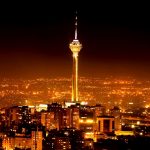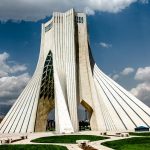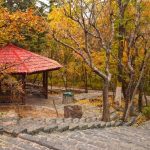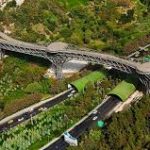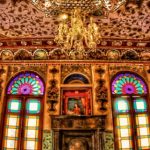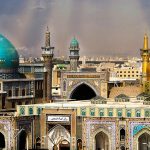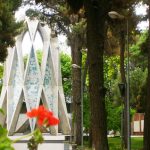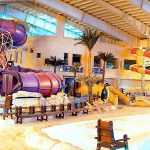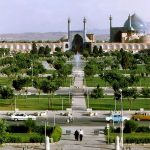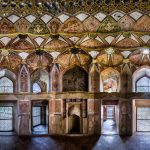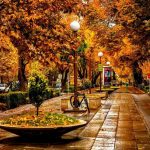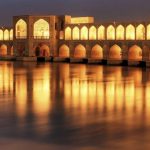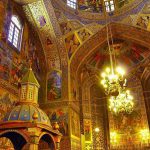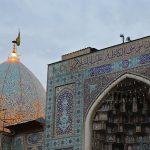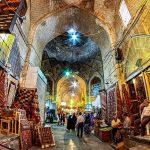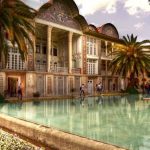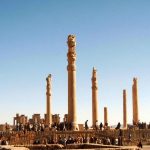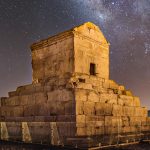Tourism in Iran is diverse, providing a range of activities from hiking and skiing in the Alborz and Zagros mountains, to beach holidays by the Persian Gulf and the Caspian Sea, but the main reason that tourist visit Iran is because of Iran Cultural and Iran history and places such as Persepolis, Naghsh-e Rostam, Naghshe Jahan and other places in Iran also we have near 22 World Cultural Heritage.
Tehran
The capital of Iran and Tehran Province and is the most populous city in Iran and Western Asia, and has the second-largest metropolitan area in the Middle East. It is ranked 29th in the world by the population of its metropolitan area. Often underrated as a tourist destination, nowhere will you sample a flavour of contemporary Iranian life more than Tehran.
The Grand Bazaar
Right in the heart of the city, the Grand Bazaar is an essential visit for any tourist in Tehran. With over 10 kilometres of labyrinthine alleyways filled with covered shops, haggling customers, and general commotion, you will find everything from jewellery to carpets and pots and pans for sale here. One of Tehran’s oldest areas, this commercial centre is teeming with history and character, and there are some exceptional restaurants dotted around. Prepare for a sensual bombardment; not for the agoraphobic! Be sure to check out the nearby Jomeh bazaar for antiques, every Friday on Jomhuri Street.
Milad Tower (Borj-e Milad)
The Milad Tower is one of Tehran’s most iconic structures, and the most prominent feature of the city’s skyline. Completed in 2007, it stands at an impressive 435 metres, making it the sixth tallest tower in the world. Trips to the head of the tower are inexpensive and worth the effort on a clear day, for nowhere else can beat it for panoramic views of the city. If you want to push the boat out, the tower also boasts a fancy, revolving restaurant.
Azadi Tower (Borj-e Azadi)
Built in 1971 to commemorate 2500 years of Persian monarchy, this iconic tower fuses elements of Sassanian, Achaemenid, and modernist architecture. Literally meaning ‘Freedom Tower’, the ivory-coloured, Y-shaped building is situated in a park in east Tehran, and features a well laid out underground museum. Though not as tall as the Milad Tower, it nevertheless boasts fantastic views of the city from the top floor.
Park-e Jamshidieh
Located in the most northerly reaches of the city, Jamshidieh is a large park in the foothills of the Alborz Mountains. Fresh air and lush surrounds are enough to merit a trip to this out-of-the-way spot, but the outstanding views of the city below are what makes it a must-see. The higher you climb, the better the views become but if you don’t feel like a hike, there are plenty of nice spots for picnicking and drinking tea. It is particularly picturesque in the winter months, when it often receives the first snowfall of the year.
Mount Tochal
Mount Tochal sits in the mountain range to the north of Tehran, with its peak reaching a staggering 3,993 metres. An excellent challenge for mountaineers, trails set off from Darakeh and Velanjak, with tea houses staggered along the way. If you lack the time or inclination for the trek, a telecabin service will take you all the way up the mountain for a reasonable fee. The top of the mountain also has a small ski piste, with equipment available to rent. Not as impressive as Dizin or Shemshak ski resorts, but ideal for a quick afternoon getaway.
Tabiat Bridge
It’s easy to see why this multilevel, sculptural pedestrian bridge, designed by Iranian architect Leila Araghian, has won awards and been a huge hit with locals. The 270m long walkway connecting Park-e Taleghani and Park-e Abo-Atash over the busy Modarres Expwy is a fun space to relax and, in good weather, it provides superb views of the north Tehran skyline against the Alborz Mountains.
National Museum of Iran
The National Museum of Iran is filled with an impressive range of treasures and objects from the 30,000 years of human habitation in the Iranian plateau. From Stone Age tools to primitive art, from decorated capitals from Persepolis to coins and pottery, the museum features items from the length and breadth of Iranian history. The building itself, designed in the early 20th century with nods to Sassanian architecture, is one of Tehran’s more interesting modern constructions.
Tehran Museum of Contemporary Art
The Tehran Museum of Contemporary Art boasts the most extensive (and valuable) collection of artworks outside Europe. Although some items have not been exhibited since the 1979 Islamic Revolution, works by big names including Picasso, Monet, Andy Warhol, and Henry Moore are on display, as well as pieces by Iranian artists. The building itself, inaugurated in 1977, is a striking modernist structure, and a great place to meet young, artsy Iranians.
Golestan palace
Just a few minutes from the Grand Bazaar, you will find the magnificent Golestan Palace, a 19th century Qajar royal abode. The palace complex consists of 17 structures in total, including reception halls, museums, throne rooms, and royal quarters, and boasts impressive, well-kept gardens too. The intricate tile work, mirrored interiors, symmetrical fountains, and marble thrones demonstrate the pinnacle of Qajar-era architecture, and provide a sense of the level of opulence the monarchs would have enjoyed.
Mashhad
Mashhad is a city in northeast Iran, known as a place of religious pilgrimage. Covering an area of 318 square km, Mashhad is the second most populous city in Iran and capital of Khorasan Razavi Province. It is located in the northeast of the country, close to the borders of Turkmenistan and Afghanistan. It was a major oasis along the ancient Silk Road connecting with Merv in the East.
Regarding its special value in the Islamic world, every year, millions of pilgrims travel to Mashhad to visit the Imam Reza shrine and pay their tributes to Imam Reza, but Mashhad is also home to some natural and historical sites such as: The tomb of Nader shah and Kooh-Sangi and some other that are mentioned bellow:
Imam Reza Holy Shrine
The Imam Reza shrine in Mashhad, Iran is a complex which contains the mausoleum of Imam Reza, the eighth Imam of Twelver Shiites. It is the largest mosque in the world by area. Also contained within the complex are the Goharshad Mosque, a museum, a library, four seminaries, a cemetery, the Razavi University of Islamic Sciences, a dining hall for pilgrims, vast prayer halls, and other buildings.
The complex is one of the tourism centers in Iran and has been described as “the heart of the Shia Iran” with millions of Iranian and non-Iranian Shias visiting the shrine each year.
The shrine itself covers an area of 267,079m2 while the seven courtyards which surround it cover an area of 331,578m2 – totaling 598,657 m2 (6,443,890 Sq. ft).
The grand dome and the Zarih were first built in the 11th century, during the Ghaznavid and Seljuq dynasties. From the beginning of the 16th century A.D. to the present day there have been five Zarihs placed around the grave of Imam Reza. The present Zarih dates from 2001, it took eight years to construct and is made of iron and wood. It is covered with silver and gold plates.
Goharshad Mosque
The Goharshad Mosque, situated in the southern part of the shrine, is one of the beautiful and glorious mosques in the world. This mosque is situated between the Bast Sheikh Baha’i and Sahn Imam Khomeini.
It was built in 9th century, Timurid dynasty, on the orders of Goharshad Bano, wife of Shahrukh Mirza, the Timurid Sultan.
The Goharshad Mosque enjoys a particular spiritual reputation among the Islamic mosques in the world. In addition to receiving many pilgrims of Imam Reza during the year, this mosque has been a center of learning and teaching the Islamic Sciences since last six centuries. The high-ranking Ulama lecture Islamic Sciences in this mosque and in the Shabistans (prayer halls) of the mentioned mosque.
Goharshad mosque has a foreground with an area of 2800 square meters and 9400 square meters infrastructure. Mosque building contains 8 spacious porches and seven yards. Dome height is about 41 meters. Its outer surface is decorated glazed brick and a Kufic inscription.
Tile mosque is an example of the masterpieces of the Timurid era. Arches of mosque with minarets and features special decorations and Mogharnas style are excellent. This ancient building can be considered as a full of prominent Iranian art that it is used all the characteristics of traditional architecture.
Name of Goharshad, founder of the mosque, is written on mosaic tiles in yellow in the north porch.
Tomb of Ferdowsi, Toos
About 40 kilometres outside of Mashhad is the small town of Toos, which is synonymous with the burial site of Iran’s national poet, Ferdowsi. The author of the epic poem, the Shahnameh (the Persian Book of Kings), Ferdowsi died in 1020 A.D, and his remains have rested in Toos ever since. The mausoleum’s current form, a massive stone structure that imitates Achaemenid architecture, was developed in the 1960s, and is the centrepiece of a surrounding park.
Tomb Of Omar Khayyam, Neishabur
The quatrains of the 12th-century astronomer-poet Omar Khayyam are perhaps Khorasan’s most famous export around the globe. Popularised by Edward Fitzgerald’s 19th-century translation, Khayyam is beloved for his pithy musings on life, death, and love. The present-day mausoleum is another unique modernist structure, built in 1963. Located in Neishapur, just over an hour outside of Mashhad, the town also houses the tomb of Attar, a Persian Sufi poet, for those wanting to tick off every box on the poetry tour.
Kang Village
Rural Khorasan has many off-the-beaten track delights to discover, often hard to access by public transport, but worth the effort of hiring a private taxi. The quaint village of Kang, about an hour’s drive from Mashhad, is one particularly charming example. Filled with mud-brick houses, stacked along the foothills of the mountains, here is a wonderful opportunity to explore one of the few communities that still practice such an authentically traditional way of life.
The best Water Park in Mashhad
Water Waves Land
The sport-cultural complex of the water park called Water Waves Land is considered as the largest indoor water park across the Middle East and in terms of expanse, being roofed and equipped with facilities, it is among the most perfect water parks of the world. Different parts of the water park are the wave pool, the waterfall, raging rivers, slow and fast slides, the black hole, the space hole, the sauna and Jacuzzi. This water park in terms of Islamic principles also is the first water park in the world where women can use the facilities in separate and special way in couple days.
Aftab (Sunshine) Coast Park
Aftab (Sunshine) Coast Park as the second largest water park in Mashhad was put into operation in summer 2011 on a land area of 4,000 square meters and 15,000 square meters of infrastructure. This complex has 7 floors and is among the world’s largest stratiform water parks in terms of the number of stories and the infrastructure. Roaring Waterfall with a height of over 18 m, speed slides, twin slides, twisting slide and 6 giant circles, unroofed slide and space hole slide, dining pool, Sputa salt pool with health and peeling skin benefits, and sand sauna are examples of attraction in the Aftab Coast Park.
Isfahan
Isfahan (historically also rendered in English as Ispahan, Sepahan) is the capital of Isfahan Province in Iran, located about 340 kilometers (211 miles) south of Tehran. It is Iran’s third largest city after Tehran and Mashhad.
Isfahan is famous for its Persian–Islamic architecture, with many beautiful boulevards, covered bridges, palaces, mosques, and minarets. This led to the Persian proverb “Esfahān nesf-e- jahān ast” (Isfahan is half of the world). Naghsh-e Jahan Square (the UNESCO World Heritage Site) in Isfahan is one of the largest city squares in the world and an outstanding example of Iranian and Islamic architecture.
Imam Square (Naqsh-e Jahan)
Before Isfahan was selected as Capital by the Safavid dynasty, a square called Naqsh-e Jahan (Image of the world) existed in the vicinity of Imam square. During the reign of Shah Abbas the Great, this square was enlarged to almost its present dimensions and the most famous historic buildings of Isfahan were constructed around this square. This square has an area of more than 85 thousand square. During the reign of Shah Abbas I and his successors, this square was an area where festivities, polo, dramatics and military parades took place. Two stone gates of the polo are embedded in the north and south of this square. The length of this great square is 500 meters from north to south, and its width about 150 meters from east to west. Most of the foreign tourists believe that Imam square is one of the greatest squares in the world. Naqsh-e Jahan Square has witnessed many historical memories of Iran during the past four centuries. Memories of the life of Shah Abbas the Great and his successors until the end of the Safavid era is associated with this great historical square.
Imam Mosque
The construction of this mosque situated at the south side of Imam Square (Naqsh-e Jahan) started in 1020 A.H under the order of Shah Abbas I during the twenty-fourth year of his reign, and the decorations and extensions of the building were completed during the rule of his successors. The chief architect and the supervisor of the building were Ostad Ali Akbar Isfahani and Moheb Ali Beik. This mosque is a masterpiece of the 16th century from the viewpoint of architecture, tile work and stone carving. One of the interesting features of this mosque is the echo of sound in the center of the gigantic dome in the southern section. The height of this dome is 52 m and the minarets therein 48m; whereas the minarets at its portal in the Naqsh-e-Jahan Square reach an elevation of 42 m. The huge one-piece marble and other slabs of stone, besides the intricate tile work and adornments prove extremely spectacular views of this mosque.
Sheikh Lotfollah Mosque
This mosque is another masterpiece of architecture and tile work of the 16th century which was constructed by a decree issued by Shah Abbas I and took a period of 18 years to be completed. The architect and mason of this structure was Ostad Mohammad Reza Isfahani. Inside tile work decorations of the plinth to the top are covered with mosaic tiles. In terms of the architectural grandeur of the mosque, foreign archaeologists believe: “It can hardly be considered a product of human hands.” Sheikh Lotfollah was one of the great pious in the Shia sect, in what is known as Lebanon today. At the invitation of Shah Abbas I, he came to reside in Isfahan. This place was constructed in honor of this great man who led the prayers and preached in this mosque.
Aali Qapu
This palace which is a unique example of palace architecture in the Safavid era was constructed under the order of Shah Abbas I in the early 11th century A.H. The monarch received special envoys in this palace and held his audience here. There are five floors in this palace and each floor has its special decorations. During the reign of Shah Abbas II, a royal parlor (Shah Neshin) was added to the main building and the sovereign and his guests watched polo, illuminations, fire-works and the dramatics that took place in the Nagsh-e-Jahan Square from the halls of this elegant palace. This palace was also called ‘Daulat Khaneh-e-Mobarakeh Nagsh-e-Jahan’ and the ‘Daulat Khaneh Palace’. Its unique archaic architecture is related to the Safavid era.
The Chehel Sutun (Forty Columns) Palace
The Chehel Sotune Palace and its garden cover an area of approximately 67,000 sq. m. This palace was constructed during the reign of Shah Abbas I and a building was established in the middle of this garden. Shah Abbas II was also responsible for additions to this palace. The reflection of the twenty pillars of the hall in the pool opposite the palace brings about a conception of forty pillars. But in fact, the number of “Forty” represents the quantity and multitude in Iran and the reason for which the mentioned building is called Chehel Sotun is the great number of the pillars in this palace.
Hasht Behesht Palace
The historical edifice of Hast Behesht, an example of residential palaces of the last kings of the Safavid dynasty, was constructed during the reign of Shah Soleiman Safavid in 1080 A.H. Tile work of the building representing different kinds of birds, wild animals and reptiles which are the remnants of this palace, can be noted. Today, only a minor portion of the grounds remains. However, the historical palace is still a valuable and interesting monument. A park has been built around it after the Revolution.
Chahar Bagh School
Chahar Bagh School, also known as Madraseh-ye Madar-e Shah (The King-mother’s School) is the last architectural masterpiece of the Safavid era. This school was constructed for theological studies, late in the reign of Shah Soltan Hossain Safavid in the years 1116-1126 AH. In terms of tile work, Chahar Bagh School contains various types of tile works which have turned it into a unique building. In fact, the school is known as the Museum of Tiling of Isfahan. King’s mother had a large caravansary built nearby, which was the most luxurious passenger accommodation about three centuries ago. This caravansary has recently been rebuilt as the most famous luxury hotel in Iran, Abbasi Hotel. The architecture structure of this hotel is spectacular and unique in the world.
Chahar Bagh Boulevard
Isfahan was chosen as the capital of Iran during the reign of Shah-Abbas I in 1006 A.H. From that time, many considerable activities started for constructing palaces, bridges and historical mosques in order to decorate the capital. Constructing a boulevard like Chahar Bagh was also taken place in this year under the command of Safavid king. Chahar Bagh Boulevard is a historical broad tree-covered avenue which connects the north of the city from Darvaze Dolat (across the current mayoral palace) to south (Darvaze Shiraz).
Si-o-se Pol
This bridge is a unique masterpiece of the reign of Shah Abbas I. It was constructed under the supervision and expense of Allah Verdi Khan, one of his famous commanders. This bridge is approximately 300 m. in length and 14 m. in width and is the longest bridge on the Zayandeh Rud River which was constructed in 1005 A.H. The Armenians used to hold special festivities near this bridge in the Safavid period. Julfa Armenians held “Khaj-Shouyan” ceremony around this bridge. This bridge is one of the masterpieces in bridge construction in Iran and the world.
Khaju Bridge (Shahi Bridge)
This bridge took its foundation in the late Timurid period and was constructed according to what it is currently in 1060 AH, under the orders of Shah Abbas II. There is a structure in the center of the bridge, known as the Beglarbegi construction which is still standing with painting decorations on the top. The same was used as a temporary residence for the royal family. The name of this bridge is a distorted version of the word ‘Khajeh’ which was a title for great personalities in the Safavid era.
Vank Cathedral
The Vank Church is one of the most famous churches in the Jolfa vicinity of Isfahan. The construction of this church commenced in the reign of Shah Abbas II in 1065 A.H and was completed in 1074 A.H. The interior of the church is richly decorated with painting decorations, interesting tile works and beautiful oil paintings of Jesus Christ’s life. Except for the religious paintings revealing an Italian and Netherlands touch, the type of its architecture and all the other decorations of this church are Iranian.
Manar Jonban (the swinging minaret)
This structure comprises of a mausoleum and two minarets, constructed on the tomb of ‘Amoo Abdollah’ a reputed personality of the 8th century A.H. The construction of Manar Jonban is based on Mongol architecture and there are tile works remained of that era. The two minarets were added later in an unknown date, but probably at the end of the Safavid era. It is extremely interesting to note that on shaking one minaret, not only does the other move, but that the structure itself sways.
Atashgah (Fire Temple)
The Atashgah of Isfahan, the top of which is made of thick and hard brick, is a Sassanid-era archaeological complex located on a hill of the same name about eight kilometers west of Isfahan. According to the historians, the Atashgah was one of the most famous fire temples in Isfahan. Although it is difficult to determine the date of the final structure, what is certain is not newer than the Sassanid period. On a low mountain about twenty kilometers west of Isfahan and in the lovely plain named Qorb overlooking the Zayandeh Rud River, remains of an old building are still left which dates back to probably the Parthian era or Sassanid period.
Old Qaisarieh Bazaar
Qaisarieh Bazaar was one of the largest and most luxurious shopping malls in the Safavid era. This bazaar which is now the greatest supplier of handicrafts in Isfahan was constructed in 1029 A.H on the north side of the Imam Square. This bazaar used to be a center of selling precious fabrics during the Safavid dynasty and foreign companies were also trading there. The entrance to the bazaar is through a majestic gateway which is decorated with paintings and mosaic tile works representing two archers with lion torso and dragon’s tail. There are two platforms situated at the either side of the entrance gateway on which the goldsmiths used to represent their goods for sale in the old days.
Shiraz
The heartland of the Persian civilization, Shiraz is the capital of the Fars Province and one of the most popular travel destinations in Iran. Pleasant in every season thanks to a mild climate, spring is the best time to go to evoke all the clichés Iran is famous for: jasmine-scented streets, orange blossom tea, poets and nightingales.
Located in central Iran, whether you like history, art, poetry or nature, Shiraz has something to offer even to the most demanding tourists. Get lost in its gardens, join Iranians reading Hafez’s poems while sitting on his grave and get intoxicated by the scent of herbs and spices at the city’s old bazaar.
It won’t take you long to realize that the few days allocated to Shiraz by classic tours and itineraries are not enough to fully enjoy the city but barely sufficient to make you understand that one day you will be back.
Vakil Bazaar
The wonderfully photogenic Vakil Bazaar is Shiraz’s main market place and home to hundreds of shops and stalls. Satisfyingly labyrinthine, the bazaar is the place for buying rugs, spices, jewellery, and household goods. Stumbling across teahouses, courtyards, caravanserais, and the traditional bathhouse, you may need more than one afternoon to explore the entirety of the Vakil Bazaar. The vaulted arched ceilings are a fine example of 18th century Zand architecture, and make for a pleasantly cool atmosphere through which to meander.
Eram Garden
Shiraz is famed for its cultivation of fine gardens, and Eram is arguably the model par excellence. Eram falls within Shiraz University’s botanical gardens, and is replete with cypress trees, trimmed hedges, and rosebushes. At its centre is a small pool and a splendid Qajar-era palace, though it is closed to the public. The garden is located just north of the Khoshk River, opposite the university.
Tomb of Hafez
Hafez is arguably the most loved and respected poet in the vast canon of Persian literature. Considered the master of the ghazal (a short, amorous, rhyming poem), Iranians from all walks of life can quote his verses on demand. His tomb resides in a well-kept garden in northeast Shiraz; more than a tourist attraction, it functions as a site of pilgrimage for his admirers the world over. Have your fortune told, visit the onsite teahouse, and contemplate the playful nuances of his lyrical ingenuity as you wander around the extensive grounds.
Tomb of Sa’di
The 13th century poet Sa’di was an important precursor to Hafez, and is one of the most cherished ancestors of modern day Shirazis. Many of his pithy maxims have attained a proverbial status, and he is widely praised for the enduring simplicity of his verse. His tomb is less busy than that of Hafez, but is located nearby and worth visiting on the same day. The underground teahouse offers a cool spot to refresh yourself after exploring the garden of roses and cypress trees.
Persepolis
Persepolis, or Takht-e Jamshid in Persian, was the magnificent ceremonial capital of the ancient Achaemenid Empire, over 2500 years ago. Ransacked by Alexander the Great, the site represents the pinnacle of ancient Iran’s political and architectural achievements. The UNESCO world heritage site is located about 70 kilometres northeast of Shiraz, and tours will take you from the city centre on a day trip. The impressive ruins require a good few hours to explore, although take plenty of water, for the midday sun can be pretty unforgiving.
Naqsh-e Rostam and Naqsh-e Rajab
A tour to Persepolis should include a visit to the nearby rock tombs and reliefs of Naqsh-e Rostam and Naqsh-e Rajab. The former consists of four massive tombs built into the face of a cliff, an appropriately ostentatious final resting place for four Achaemenid kings. Below you will see some stone reliefs depicting various Sassanian imperial triumphs, such as the Roman Emperor Valyerian kneeling before Shapur I. Four more Sassanian reliefs can be found at the less well-tended Naqsh-e Rajab, only five minutes away.
Pasargadae
The final stop on your day-trip outside the city should be Pasargadae, an Achaemenid political centre that predates Persepolis. Another 50 kilometres north of its more famous successor, it’s not the most convenient of destinations, but the striking solemnity of Cyrus the Great’s ancient tomb, now surrounded by inhospitably harsh terrain, justifies the effort. The founder of the Achaemenid Empire, his isolated tomb is built upon a broad-stepped base, and was allegedly visited by Alexander the Great himself, after he conquered Persepolis.
